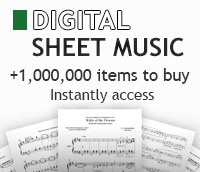For centuries, the chorale "Ich ruf zu dir, Herr Jesus
Christ" (I call to you, Lord Jesus Christ) was
anonymously included in most German hymn books. This
might be due to the fact that the author Agricola came
into conflict with Martin Luther, which resulted in
anonymous listing in the lutheran hymnbooks. Starting
in the second half of the seventeenth century until far
in the 19th century Paul Speratus was thought to be the
author. It is a composition of great quality. It is a
small partita, in ...(+)
For centuries, the chorale "Ich ruf zu dir, Herr Jesus
Christ" (I call to you, Lord Jesus Christ) was
anonymously included in most German hymn books. This
might be due to the fact that the author Agricola came
into conflict with Martin Luther, which resulted in
anonymous listing in the lutheran hymnbooks. Starting
in the second half of the seventeenth century until far
in the 19th century Paul Speratus was thought to be the
author. It is a composition of great quality. It is a
small partita, in three parts, based on three different
verses of the choral. The first of these three has the
chorale melody in the pedal part. Intruiging is that
the composer alternates the octaves in which the
phrases are played: two in the great octave, then two
in the small octave, then again two in the great and
the last two in the small.
Versus two and three are to be played with the hands on
different manuals. The right hand plays an embellished
version of the chorale melody, left hand and feet
provide a suitable accompaniment, often based on the
fragment of the chorale melody the right hand is about
to play. Botyh versus can easily compare with the best
of the work in this genre of Dietrich Buxtehude. Though
this description is the same for both verses, the
result is vastly different.
Both the second and third part pose a problem in
rendering them in ‘modern’ notation. Both hands
play on different manuals and the composers uses this
fact in having the voices overlap and even cross. The
accompaniment is often higher than the solo voice. And
in between phrases, where both hands can play on the
accompanying manual, the alto and tenor voice are
somtimes far apart (from e in the small octave to g in
the one-lined octave). This is easy to notate in German
organ tabulature. It is easy to notate using the alto
clef. However, not many people can read the alto clef,
so ‘modern’ notation confines it self to treble and
bass clef. And that is a problem in this composition.
The accompaniment should either be notated on two
staves (bringing the total to four) or the
accompaniment must spread out on the staff for the
right and/or the staff for the pedals, obscuring
readability.
Source: CPDL
(https://www.cpdl.org/wiki/index.php/Ich_ruf_zu_dir,_He
rr_Jesu_Christ).
Although originally written for Voice & period
instruments (Soprano, Alto & Basso Continuo), I created
this Interpretation of "Ich ruf zu dir, Herr Jesus
Christ" (I call to you, Lord Jesus Christ) for Solo
Piano.















